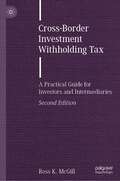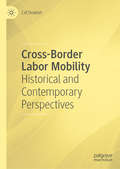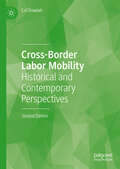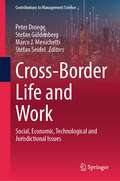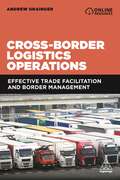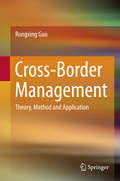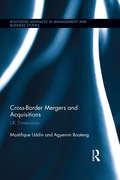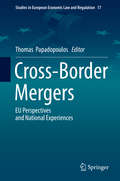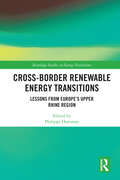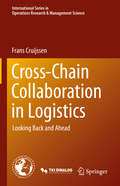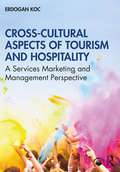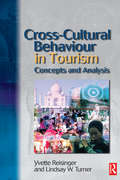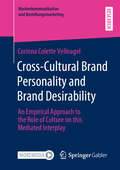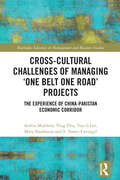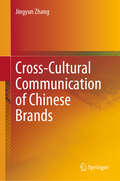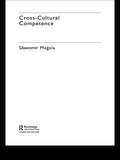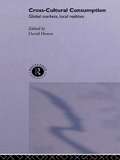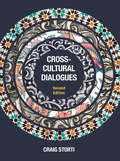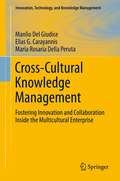- Table View
- List View
Cross-Border Investment Withholding Tax: A Practical Guide for Investors and Intermediaries (Finance and Capital Markets Series)
by Ross K. McGillThis book provides a clear and concise explanation of withholding tax and how to leverage best practice to generate improved investment performance. It gives practical guidance to financial service firms and investors to help them understand the issues involved, trends and practicalities of maximizing returns on investment.Most of the $200 billion of withholding tax lost by investors annually is due to lack of awareness and not asking the right questions of their brokers and custodian banks. Financial institutions are also increasingly being held to a higher standard by investors for provision of withholding tax services because of the impact it can have on portfolio performance. This book seeks to raise awareness of the issues and provide more detail about how the system works and what challenges and changes readers should expect in the future.
Cross-Border Labor Mobility: Historical and Contemporary Perspectives
by Caf DowlahThis book presents a comprehensive review of cross-border labor mobility from the ancient forms of slavery to the present day. The book covers African and Amerindian slaveries, indentured servitude of the Indians and the Chinese, guestworker programs, and contemporary labor migration focusing on the United States, the European Union, and the Gulf Region. The book highlights the economics and politics that condition such trends and patterns by addressing growing anti-immigrant sentiments, as well as restrictive measures in the developed world, and outlines inexorable forces that are likely to propel further expansion of cross-border mobility in the future. This multidisciplinary volume provides a highly dependable scholarly reference to researchers, students, academics as well as policy makers.
Cross-Border Labor Mobility: Historical and Contemporary Perspectives
by Caf DowlahThis revised and updated book provides unique insight into cross-border labor mobility, from the ancient forms of slavery to the present day. With a focus on the economic factors that underpin human mobility across the world, it charts the different forms of migration from African and Amerindian slaveries, to modern global migration and human trafficking. By highlighting the economic and political conditions that drive human mobility and anti-immigrant sentiments, a nuanced and detailed understanding of the drivers of forced and voluntary cross-border mobility are presented. This book presents a multidisciplinary understanding of the patterns and processes that define human mobility. It will be of interest to students, researchers, and policymakers working within labour economics and migration studies.
Cross-Border Life and Work: Social, Economic, Technological and Jurisdictional Issues (Contributions to Management Science)
by Stefan Seidel Peter Droege Stefan Güldenberg Marco J. MenichettiThis book discusses the risks, challenges, and opportunities of cross-border work and life from a multidisciplinary and multilevel perspective, including (a) the individual, (b) the social and organizational, and (c) the regional levels, taking into consideration the diverse and multilayered social, economic, technological, and jurisdictional issues involved.Emerging public policies and advanced information technologies (IT) have created new opportunities for work and life that thrive in global value chains and markets. Life, in general, and work, in particular, are increasingly organized across borders of various kinds and are subject to rapid change. At the same time, life and work have been determined by 19th and 20th century infrastructures and technologies. As a consequence, new strategies and measures are required for both physical and virtual work and life spaces.
Cross-Border Listings and Depositary Receipts
by Mihir A. Desai Mark F. Veblen Kathleen Luchs Ami Dave Maria Raga-FrancesThis case describes the varied instruments that have evolved to facilitate investments in foreign corporations, emphasizing American Depositary Receipts (ADRs) and cross-border listings. It describes the different types of ADRs and the regulatory requirements foreign corporations must meet to list their shares on U.S. stock exchanges. It examines the evolution of cross-border listings as well as recent developments, such as Globally Registered Shares. It also reviews the academic research on the motivations for cross-border listings and provides information on managerial views on the advantages and disadvantages of cross-border listings.
Cross-Border Logistics Operations: Effective Trade Facilitation and Border Management
by Andrew GraingerWith considerable turmoil in international trade and logistics it is more important than ever to understand trade and customs issues and their impact on logistics operations. At every port and border international freight operations are exposed to trade and customs procedures.Cross-Border Logistics Operations serves as a comprehensive guide and companion to the cross-border trade and customs environment and its implications for international business supply chains and their control. Inspired by the World Customs Organization's Professional Standards (also known as the WCO PICARD Standards), it provides key insights into transporting goods across borders and effectively managing the requirements for compliance and enforcement.International students, business operators and government officials will find the book rich in detail with practical examples that include the political, administrative, regulatory, technological and economic context throughout. It covers all the critical operational and legal aspects of cross-border logistics operations, including:-prevailing trade, customs and border policy-tariffs and import taxes -border management and supply chain security practices-prohibitions and restrictions-enforcement and compliance practices-supply chain and logistics arrangements-disaster relief operations-frictionless trade and trade facilitation principles.
Cross-Border Management: Theory, Method and Application (Developments In Environmental Science Ser. #4)
by Rongxing GuoThis book presents a new approach to management in an increasingly interactive world. In this context, the use of the word "new" has two meanings. The first relates to a new definition of borders (which are natural, institutional, functional, or mixed); the second concerns the fact that the book applies (and, where necessary, develops) analytical tools, methods and models that are different from those used in other similar books. The objectives of this book are: to clarify whether existing management theories and methods can be effectively applied in an entity (which can be defined as a sovereign country, a region, a community, a culture, or a firm) as the latter increasingly interacts with the rest of the world; to develop qualitative and quantitative methods to help leaders make optimal decisions for their entity and, at the same time, to maximize the positive (or minimize the negative) effects of those decisions on the rest of the world; and to design workable cross-border cooperation plans and conflict-management schemes that allow policy-makers to better cope with the challenges and problems posed by our increasingly interactive world.
Cross-Border Mergers and Acquisitions: UK Dimensions (Routledge Advances in Management and Business Studies)
by Moshfique Uddin Agyenim BoatengCross-border mergers and acquisitions (CBM&As) activity has become an important vehicle for firms’ internationalization and corporate restructuring over the past three decades. Despite the huge volume of global CBM&A activity, however, there are few books which carefully explore the strategies, motives, and consequences of global mergers and acquisitions. This book discusses and synthesizes the theoretical literature on the motivation and performance of international merger activities. Focusing on the UK as a top acquiring country in the European Union, the authors explore the recent trends in cross-border mergers and acquisitions, motives for cross-border mergers and acquisitions, the mergers integration process, home and host countries’ macroeconomic consequences on mergers and acquisitions, and shareholder’s wealth effects on CBM&A. This book explores and sheds much-needed light on the UK CBM&A market, what drives it, and what lessons can be learned for other regions around the globe.
Cross-Border Mergers in Europe
by Dirk Van GervenThis discussion of the Cross-Border Merger Directive and its implementing legislation in each Member State of the European Union and the European Economic Area provides companies and their advisors with useful insight into the legal framework applicable to, and the tax treatment of, cross-border mergers throughout the European Economic Area. Analysis of the Community rules laid down in the Cross-Border Merger Directive and the Community rules on the tax treatment of cross-border mergers is complemented by chapters on the implementing legislation in each Member State, prepared in accordance with a common format and contributed by a practitioner from each state. Annexes contain the Cross-Border Merger Directive (Annex I), the Parent-Subsidiary Directive (Annex II) and a list of the implementing legislation in each Member State (Annex III).
Cross-Border Mergers: EU Perspectives and National Experiences (Studies in European Economic Law and Regulation #17)
by Thomas PapadopoulosThis edited volume focuses on specific, crucially important structural measures that foster corporate change, namely cross-border mergers. Such cross-border transactions play a key role in business reality, economic theory and corporate, financial and capital markets law. Since the adoption of the Cross-border Mergers Directive, these mergers have been regulated by specific legal provisions in EU member states. This book analyzes various aspects of the directive, closely examining this harmonized area of EU company law and critically evaluating cross-border mergers as a method of corporate restructuring in order to gain insights into their fundamental mechanisms. It comprehensively discusses the practicalities of EU harmonization of cross-border mergers, linking it to corporate restructuring in general, while also taking the transposition of the directive into account. Exploring specific angles of the Cross-border Mergers Directive in the light of European and national company law, the book is divided into three sections: the first section focuses on EU and comparative aspects of the Cross-border Mergers Directive, while the second examines the interaction of the directive with other areas of law (capital markets law, competition law, employment law, tax law, civil procedure). Lastly, the third section describes the various member states’ experiences of implementing the Cross-border Mergers Directive.
Cross-Border Outsourcing and Boundaries of Japanese Firms: A Microdata Economic Analysis (Advances in Japanese Business and Economics #18)
by Eiichi TomiuraThis book is the first book that provides comprehensive economic analysis of cross-border outsourcing by Japanese manufacturing firms based on microdata. Previous literature on many other countries has often been constrained by limited data availability about outsourcing, but research contained in this book exploits unique firm-level data and directly tests theoretical hypotheses derived from new firm heterogeneity trade models. Productivity, capital–labor ratio and R&D intensity are examined at the firm level. While rich empirical results in this book convince us how powerful the orthodox economic theory is in understanding Japanese firms, detailed firm-level findings, combined with accessible and concise overviews of Japanese international trade, are widely informative for international economists, experts of Japanese society, business strategists for offshoring, and policy makers in both developed and developing economies. This book further discusses how boundaries of Japanese firms, traditionally sheltered by language and cultural barriers, are affected by outsourcing decisions simultaneously crossing national borders and firm boundaries. The interpretations of Japanese characteristics in outsourcing have deep implications for understanding drastically changing Japanese business amid globalization.
Cross-Border Renewable Energy Transitions: Lessons from Europe's Upper Rhine Region (Routledge Studies in Energy Transitions)
by Philippe HammanThis book explores the intrinsically multiscale issue of renewable energy transition from a local, national and transnational perspective, and provides insights into current developments in the Upper Rhine Region that can serve as an international model. Organised around the exploration of stakeholder issues, the volume first describes a framework for public action and modelling and then articulates a triple complementary focus from the viewpoint of law, economics and sociology. This multidisciplinary approach is anchored in the social sciences, but also explores the ways in which technological issues are increasingly debated in the implementation of the ecological transition. With a focus on the Upper Rhine Region of France, Germany and Switzerland, the contributions throughout analyse how concrete regional projects emerge, and whether they are carried out by local authorities, private energy groups, network associations or committed citizens. From this, it appears that real-world energy transition modes can be best understood as permanent transactional processes involving institutional regulations, economic levers and barriers and social interactions. This book will be of interest to advanced students and scholars focusing on renewable energy transition, stakeholder issues, environment and sustainability studies, as well as those who are interested in the methodological aspects of the social sciences, especially within the fields of sociology, law, economy, geography, political science, urbanism and planning.
Cross-Border Valuation
by Kenneth A. Froot W. Carl KesterProvides a review of valuation techniques used to assess cross-border investments. Discusses the discounting of free cash flows with a weighted average cost of capital and the use of adjusted present value. Special concerns such as foreign-exchange risk, country risks, and international diversification are also discussed. Unlike Note on Cross-Border Valuation, this note contains no discussion of valuing real options. A rewritten version of an earlier note.
Cross-Chain Collaboration in Logistics: Looking Back and Ahead (International Series in Operations Research & Management Science #297)
by Frans CruijssenThis book examines cross-chain control centers (4C), an ambitious concept in supply chain management and logistics that is intended to foster collaboration between different supply chains to increase efficiency. It provides an overview of the main results, insights, and other developments in the academic field of horizontal collaboration. Furthermore, it gives recommendations to governments, commercial companies, and academia on how to proceed with horizontal logistics collaboration in the years to come. To link research with practice, the book takes the Dutch project on cross-chain collaboration centers (4Cs) and identifies a typology of existing patterns for horizontal collaboration in supply chains. Finally, the book zooms in on the Netherlands as a case-study of intense public-private partnerships to develop 4C as a mature logistics value proposition. It provides an overview of the accomplishments in the government supported 4C projects and offers a critical reflection of why some more ambitious and structural solutions have not found solid ground yet. The book is of value to researchers and professionals in the supply chain domain.
Cross-Cultural Aspects of Tourism and Hospitality: A Services Marketing and Management Perspective
by Erdogan KocCross-Cultural Aspects of Tourism and Hospitality is the first textbook to offer students, lecturers, researchers and practitioners a comprehensive guide to the influence of culture on service providers as well as on customers, affecting both the supply and the demand sides of the industry – organisational behaviour, and human resource management, and marketing and consumer behaviour. Given the need for delivering superior customer value, understanding different cultures from both demand and supply sides of tourism and hospitality and the impact of culture on these international industries is an essential part of all students’ and practitioners’ learning and development. This book takes a research-based approach critically reviewing seminal cultural theories and evaluating how these influence employee and customer behaviour in service encounters, marketing, and management processes and activities. Individual chapters cover a diverse range of cultural aspects including intercultural competence and intercultural sensitivity, uncertainty and risk avoidance, context in communication, power distance, indulgence and restraint, time orientation, gender, assertiveness, individualism and collectivism, performance orientation, and humane orientation. This book integrates international case studies throughout to show the application of theory, includes self-test questions, activities, further reading, and a set of PowerPoint slides to accompany each chapter. This will be essential reading for all students, lecturers, researchers and practitioners and future managers in the fields of Tourism and Hospitality.
Cross-Cultural Behaviour in Tourism: Concepts And Analysis
by Lindsay Turner Yvette Reisinger, PhDCross-Cultural Behaviour in Tourism: Concepts and Analysis is important reading for those in the following areas of industry: * Tourism: illustrates the importance of cultural background in the tourist experience and how it is a major determinant in repeat visitation * Marketing: provides an understanding of the cultural background of a destination that is vital when formulating successful marketing strategies * Management: provides valuable examples on how cultures influence tourist behaviour and decision-making, helping managers to develop cross-cultural skills and deal with tourists from diverse cultural backgrounds Tourism is a service industry where people from different nationalities meet. In today's international marketplace it is imperative that those in the industry understand the influence of national cultures on their consumers in order to compete successfully for a market share. The book is accompanied by online resources which can be found at www.bh.com/companions/0750656689. These resources include an account of Hypothesis Testing, together with a detailed glossary and a comprehensive reference list of relevant materials.
Cross-Cultural Brand Personality and Brand Desirability: An Empirical Approach to the Role of Culture on this Mediated Interplay (Markenkommunikation und Beziehungsmarketing)
by Corinna Colette VellnagelThis research proposes and empirically tests the impact of brand personality dimensions on brand desirability in a cross-cultural context. Further, the concept of brand-self-congruity is tested on its mediating role between brand personality dimensions and brand desirability. The results reveal that certain brand personality dimensions can have a direct and/ or indirect impact on brand desirability. Yet, this effect mechanism has not only been found to be brand-dependent but also culture-dependent. In this context, the mediating role of brand-self-congruity was confirmed across all cultures and brands investigated. Important implications are derived for research and brand management. In different countries, different brand personality dimensions lead to brand desirability. Therefore, brand managers should know their markets, understand cultural differences and adjust their brand strategy accordingly in order to attain brand desirability.
Cross-Cultural Challenges of Managing ‘One Belt One Road’ Projects: The Experience of the China-Pakistan Economic Corridor (Routledge Advances in Management and Business Studies)
by Ying Zhu You-il Lee Mary Bambacas Arshia Mukhtar S.Tamer CavusgilThe China Pakistan Economic Corridor (CPEC) is a flagship program of China’s ‘One Belt One Road’ initiative, created to boost economic cooperation between China and Pakistan with significant political and economic implications in the region. This book looks at critical issues when developing capabilities of cross-cultural management, adaptation and adjustment through cross-cultural understanding and network building from the CPEC case study. The book highlights the importance of acculturation experience, cross-cultural networking, networking behaviour (guanxi vs. hawala), and factors influencing cross-cultural adjustment, which would enhance the overall performance of ‘One Belt One Road’ projects in general. It looks at how the Chinese and Pakistani employees' national cultures affect their behaviour while working on the CPEC projects. The book offers insights into what cross-cultural adjustments are effective in creating improved individual and organizational performance. In an increasingly globalized world in which the practice of working with people from multiple cultural background is more of a norm, this book will be a useful reference for those who are interested to achieve success in multi-cultural settings.
Cross-Cultural Communication of Chinese Brands
by Jingyun ZhangThis book presents theoretical insights into key aspects of Chinese brand cross-cultural communication, such as psychological distance, implicit context, brand narrative and influence of bridge crowds.This book applies the psychological distance theory of communication to study the psychological distance strategy of cross-cultural communication of Chinese brands from macro and micro perspectives, and proposes to resolve cultural differences by adjusting psychological distance. Based on the above theories,the authors construct the cross-cultural communication strategy model for Chinese brands, in which the following models have been proposed, such as the stages of globalization for Chinese brands, Internationalization of Chinese Enterprises (general as well as several application models).Chapter IX includes five cases studies, including Huawei, CRRC Yongji, COFCO, Yili Thailand and the " Walking Lunar New Year's Eve Dinner" project, which represent four types of brands: high-end equipment, fast moving consumer goods, high technology and cultural activities brand.This book not only provides readers with a broader understanding of brand cross-cultural communication research, but also offers practical suggestions for companies in emerging market countries , especially Chinese enterprises that are undergoing brand globalization.
Cross-Cultural Competence
by Slawomir MagalaCross-cultural management is a crucial challenge for the successful development of international business, yet it is often badly understood and poorly implemented. Misunderstandings arise as culture affects both individuals and organizations, yet attempts to understand, explain and interpret these differences have often been hidden between a welter of conflicting theories and paradigms. This book is a much-needed guide to the theory and practice of cross-cultural management. It focuses on four key areas: the language connection the global connection the management connection the multimedia connection. Using an innovative approach combining theory, tool-kits and applications, it takes a fresh look at this complex topic, investigating the recognition of cross-cultural differences, accounting for them in managerial communications, and bridging them in a variety of negotiations, interactions and collaborative projects.
Cross-Cultural Consumption: Global Markets, Local Realities
by David HowesGoods are imbued with meanings and uses by their producers. When they are exported, they can act as a means of communication or domination. However, there is no guarantee that the intentions of the producer will be recognized, much less respected, by the consumer from another culture. Cross-Cultural Consumption is a fascinating guide to the cultural implications of the globalization of a consumer society. The chapters address topics ranging from the clothing of colonial subjects in South Africa and the rise of the hypermarket in Argentina, to the presentation of culture in international tourist hotels. Through their examination of cultural imperialism and cultural appropriation of the representation of otherness and identity, Howes and his contributors show how the increasingly global flow of goods and images challenges the very idea of the cultural border and creates new spaces for cultural invention. Marian Bredin, Concordia University, Constance Classen, Jean Comaroff, University of Chicago, Mary Crain, University of Barcelona, Carol Handrickson, Marlboro Colleg
Cross-Cultural Dialogues
by Craig StortiCulture affects everything we do: the simplest phrase can be so steeped in cultural context that even seemingly innocent exchanges between people are loaded with cultural differences waiting to expand into misunderstanding and tension. In response, Cross-Cultural Dialogues: 74 Brief Encounters with Cultural Difference offers a collection of 74 brief conversations between an American and people from other cultures, spanning nearly every major region of the world. Each dialogue is categorized as a social, workplace or business interaction and contains at least one breach of cultural norms, which the reader is then challenged to address. Even the most careful reader will be caught off guard by some of the dialogues' hidden subtleties. Storti is meticulous in his analysis of each dialogue, pinpointing not only the moment when the interaction goes wrong, but also identifying the cultural reasons behind each participant's point of view. Whether training others or adding to your own cultural awareness, Cross Cultural Dialogues is an excellent resource, encouraging readers to engage in the world and increase their multicultural understanding.
Cross-Cultural Dialogues: 74 Brief Encounters with Cultural Difference
by Craig StortiCulture affects everything we do: the simplest phrase can be so steeped in cultural context that even seemingly innocent exchanges between people are loaded with cultural differences waiting to expand into misunderstanding and tension. In response, Cross-Cultural Dialogues: 74 Brief Encounters with Cultural Difference offers a collection of 74 brief conversations between an American and people from other cultures, spanning nearly every major region of the world. Each dialogue is categorized as a social, workplace or business interaction and contains at least one breach of cultural norms, which the reader is then challenged to address. Even the most careful reader will be caught off guard by some of the dialogues' hidden subtleties. Storti is meticulous in his analysis of each dialogue, pinpointing not only the moment when the interaction goes wrong, but also identifying the cultural reasons behind each participant's point of view. Whether training others or adding to your own cultural awareness, Cross Cultural Dialogues is an excellent resource, encouraging readers to engage in the world and increase their multicultural understanding.
Cross-Cultural Dialogues: 74 Brief Encounters with Cultural Difference
by Craig StortiHow much culture lurks in common conversation? According to Craig Storti, so much that many of our most common, seemingly innocent exchanges—in social settings, on the job, in the world of business—are cultural minefields waiting to explode. These explosions—cultural misunderstandings—can cause confusion, irritation, even alienation. At the workplace and in the world of business these explosions undermine communication, threaten important relationships, and cost a great deal of time and money; away from work, they strain, even endanger, personal relations. Cross-Cultural Dialogues is a collection of brief conversation (4-8 lines) between an American and someone from another country and culture. Short as each dialogue is, it has buried within it at least one, and usually several breaches of cultural norms which the reader is challenges to figure out. And a challenge it is: the exchanges are so brief and innocuous that even the wariest among us are sandbagged by the dialogue’s hidden subtleties. Ten cultures are represented by the non-Americans in the dialogues: Arab/Middle Eastern, British, Chinese, French, German, Hispanic, Indian, Japanese, Mediterranean/European, and Russian, and the dialogues are grouped according to the setting in which they occur: social, workplace, and business. Whether you’re a learner, trainer, educator, or an armchair interculturalist, you’ll enjoy solving these cultural riddles—and increase your cultural awareness in the bargain.
Cross-Cultural Knowledge Management: Fostering Innovation and Collaboration Inside the Multicultural Enterprise (Innovation, Technology, and Knowledge Management #11)
by Maria Rosaria Della Peruta Manlio Del Giudice Elias G. CarayannisCross-cultural knowledge management, an elusive yet consequential phenomenon, is becoming an increasingly essential factor in organizational practice and policy in the era of globalization. In order to overcome culturally shaped blind spots in conducting research in different settings, this volume highlights how the structuring of roles, interests, and power among different organizational elements, such as teams, departments, and management hierarchies (each comprised of members from different intellectual and professional backgrounds), generates various paradoxes and tensions that bring into play a set of dynamics that have an impact on learning processes. In this context, such questions often arise: How is knowledge shared in the multicultural organization? What problems and issues emerge? How do different mentalities affect people's responses to new knowledge and new ideas? How can knowledge-sharing processes be improved? Under which conditions do ideas generated by units or groups of different cultural traditions have a chance of being heard and implemented? Such questions translate into an investigation of potential managerial dilemmas that occur when different but equally valid choices create tensions in decision making. The authors draw from experiences working with a wide variety of organizations, and insights from such fields as sociology and psychology, to shed new light on the dynamics of knowledge management in the multicultural enterprise. In so doing, they help to identify both obstacles to successful communication and opportunities to inspire creativity and foster collaboration. The authors note that in order to enable organizations to transfer knowledge effectively, mechanisms for dispute settlement, mediation of cultural conflict, and enforcing agreements need to be in place.
